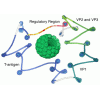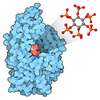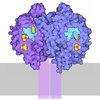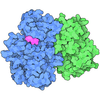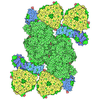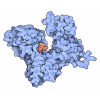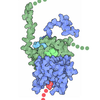+ データを開く
データを開く
- 基本情報
基本情報
| 登録情報 | データベース: PDB / ID: 9c7t | |||||||||
|---|---|---|---|---|---|---|---|---|---|---|
| タイトル | PP2A:B55-Eya3 substrate complex | |||||||||
 要素 要素 |
| |||||||||
 キーワード キーワード | HYDROLASE/SUBSTRATE / PP2A:B55 / Eya3 / substrate complex / HYDROLASE / HYDROLASE-SUBSTRATE complex | |||||||||
| 機能・相同性 |  機能・相同性情報 機能・相同性情報histone H2AXY142 phosphatase activity / regulation of chromosome segregation / meiotic spindle elongation / Integration of energy metabolism / PP2A-mediated dephosphorylation of key metabolic factors / RNA polymerase II CTD heptapeptide repeat S2 phosphatase activity / RNA polymerase II CTD heptapeptide repeat S7 phosphatase activity / mitotic sister chromatid separation / MASTL Facilitates Mitotic Progression / protein phosphatase type 2A complex ...histone H2AXY142 phosphatase activity / regulation of chromosome segregation / meiotic spindle elongation / Integration of energy metabolism / PP2A-mediated dephosphorylation of key metabolic factors / RNA polymerase II CTD heptapeptide repeat S2 phosphatase activity / RNA polymerase II CTD heptapeptide repeat S7 phosphatase activity / mitotic sister chromatid separation / MASTL Facilitates Mitotic Progression / protein phosphatase type 2A complex / protein serine/threonine phosphatase complex / regulation of meiotic cell cycle process involved in oocyte maturation / peptidyl-threonine dephosphorylation / meiotic sister chromatid cohesion, centromeric / INTAC complex / RNA polymerase II CTD heptapeptide repeat S5 phosphatase activity / FAR/SIN/STRIPAK complex / Regulation of glycolysis by fructose 2,6-bisphosphate metabolism / Inhibition of replication initiation of damaged DNA by RB1/E2F1 / female meiotic nuclear division / protein phosphatase regulator activity / GABA receptor binding / APC truncation mutants have impaired AXIN binding / AXIN missense mutants destabilize the destruction complex / Truncations of AMER1 destabilize the destruction complex / protein antigen binding / ERKs are inactivated / Initiation of Nuclear Envelope (NE) Reformation / positive regulation of extrinsic apoptotic signaling pathway in absence of ligand / Beta-catenin phosphorylation cascade / Signaling by GSK3beta mutants / CTNNB1 S33 mutants aren't phosphorylated / CTNNB1 S37 mutants aren't phosphorylated / CTNNB1 S45 mutants aren't phosphorylated / CTNNB1 T41 mutants aren't phosphorylated / RNA polymerase II transcription initiation surveillance / Co-stimulation by CD28 / regulation of growth / Disassembly of the destruction complex and recruitment of AXIN to the membrane / negative regulation of epithelial to mesenchymal transition / response to morphine / Co-inhibition by CTLA4 / response to ionizing radiation / Platelet sensitization by LDL / protein-serine/threonine phosphatase / negative regulation of glycolytic process through fructose-6-phosphate / positive regulation of NLRP3 inflammasome complex assembly / ERK/MAPK targets / mesoderm development / protein serine/threonine phosphatase activity / vascular endothelial cell response to oscillatory fluid shear stress / T cell homeostasis / regulation of cell differentiation / regulation of G1/S transition of mitotic cell cycle / regulation of microtubule polymerization / phosphoprotein phosphatase activity / lateral plasma membrane / chromosome, centromeric region / DARPP-32 events / anatomical structure morphogenesis / negative regulation of extrinsic apoptotic signaling pathway in absence of ligand / enzyme-substrate adaptor activity / negative regulation of hippo signaling / Nonsense Mediated Decay (NMD) enhanced by the Exon Junction Complex (EJC) / Cyclin A/B1/B2 associated events during G2/M transition / protein dephosphorylation / spindle assembly / Amplification of signal from unattached kinetochores via a MAD2 inhibitory signal / visual perception / Mitotic Prometaphase / protein-tyrosine-phosphatase / EML4 and NUDC in mitotic spindle formation / Loss of Nlp from mitotic centrosomes / Loss of proteins required for interphase microtubule organization from the centrosome / Recruitment of mitotic centrosome proteins and complexes / negative regulation of phosphatidylinositol 3-kinase/protein kinase B signal transduction / Recruitment of NuMA to mitotic centrosomes / Anchoring of the basal body to the plasma membrane / protein tyrosine phosphatase activity / Resolution of Sister Chromatid Cohesion / positive regulation of DNA repair / protein phosphatase 2A binding / AURKA Activation by TPX2 / Turbulent (oscillatory, disturbed) flow shear stress activates signaling by PIEZO1 and integrins in endothelial cells / Spry regulation of FGF signaling / meiotic cell cycle / chromosome segregation / Degradation of beta-catenin by the destruction complex / RHO GTPases Activate Formins / RAF activation / negative regulation of canonical Wnt signaling pathway / PKR-mediated signaling / Negative regulation of MAPK pathway / response to lead ion / tau protein binding / Cyclin D associated events in G1 / Separation of Sister Chromatids / Regulation of TP53 Degradation / spindle pole / Regulation of PLK1 Activity at G2/M Transition 類似検索 - 分子機能 | |||||||||
| 生物種 |  Homo sapiens (ヒト) Homo sapiens (ヒト) | |||||||||
| 手法 | 電子顕微鏡法 / 単粒子再構成法 / クライオ電子顕微鏡法 / 解像度: 2.7 Å | |||||||||
 データ登録者 データ登録者 | Page, R. / Peti, W. / Padi, S. / Godek, R.J. | |||||||||
| 資金援助 |  米国, 2件 米国, 2件
| |||||||||
 引用 引用 |  ジャーナル: Nat Struct Mol Biol / 年: 2025 ジャーナル: Nat Struct Mol Biol / 年: 2025タイトル: Cryo-EM structures of PP2A:B55 with p107 and Eya3 define substrate recruitment. 著者: Sathish K R Padi / Rachel J Godek / Wolfgang Peti / Rebecca Page /  要旨: Phosphoprotein phosphatases (PPPs) achieve specificity by binding substrates and regulators using PPP-specific short motifs. Protein phosphatase 2A (PP2A) is a highly conserved phosphatase that ...Phosphoprotein phosphatases (PPPs) achieve specificity by binding substrates and regulators using PPP-specific short motifs. Protein phosphatase 2A (PP2A) is a highly conserved phosphatase that regulates cell signaling and is a tumor suppressor. Here, we use cryo-electron microscopy and nuclear magnetic resonance (NMR) spectroscopy to investigate the mechanisms of human p107 substrate and Eya3 regulator recruitment to the PP2A:B55 holoenzyme. We show that, while they associate with B55 using a common set of interaction pockets, the mechanism of substrate and regulator binding differs and is distinct from that observed for PP2A:B56 and other PPPs. We also identify the core B55 recruitment motif in Eya3 proteins, a sequence conserved amongst the Eya family. Lastly, using NMR-based dephosphorylation assays, we demonstrate how B55 recruitment directs PP2A:B55 fidelity through the selective dephosphorylation of specific phosphosites. As PP2A:B55 orchestrates mitosis and DNA damage repair, these data provide a roadmap for pursuing new avenues to therapeutically target this complex by individually blocking a subset of regulators that use different B55 interaction sites. #1:  ジャーナル: Nature / 年: 2024 ジャーナル: Nature / 年: 2024タイトル: Cryo-EM structures of PP2A:B55-FAM122A and PP2A:B55-ARPP19. 著者: Sathish K R Padi / Margaret R Vos / Rachel J Godek / James R Fuller / Thomas Kruse / Jamin B Hein / Jakob Nilsson / Matthew S Kelker / Rebecca Page / Wolfgang Peti /   要旨: Progression through the cell cycle is controlled by regulated and abrupt changes in phosphorylation. Mitotic entry is initiated by increased phosphorylation of mitotic proteins, a process driven by ...Progression through the cell cycle is controlled by regulated and abrupt changes in phosphorylation. Mitotic entry is initiated by increased phosphorylation of mitotic proteins, a process driven by kinases, whereas mitotic exit is achieved by counteracting dephosphorylation, a process driven by phosphatases, especially PP2A:B55. Although the role of kinases in mitotic entry is well established, recent data have shown that mitosis is only successfully initiated when the counterbalancing phosphatases are also inhibited. Inhibition of PP2A:B55 is achieved by the intrinsically disordered proteins ARPP19 and FAM122A. Despite their critical roles in mitosis, the mechanisms by which they achieve PP2A:B55 inhibition is unknown. Here, we report the single-particle cryo-electron microscopy structures of PP2A:B55 bound to phosphorylated ARPP19 and FAM122A. Consistent with our complementary NMR spectroscopy studies, both intrinsically disordered proteins bind PP2A:B55, but do so in highly distinct manners, leveraging multiple distinct binding sites on B55. Our extensive structural, biophysical and biochemical data explain how substrates and inhibitors are recruited to PP2A:B55 and provide a molecular roadmap for the development of therapeutic interventions for PP2A:B55-related diseases. | |||||||||
| 履歴 |
|
- 構造の表示
構造の表示
| 構造ビューア | 分子:  Molmil Molmil Jmol/JSmol Jmol/JSmol |
|---|
- ダウンロードとリンク
ダウンロードとリンク
- ダウンロード
ダウンロード
| PDBx/mmCIF形式 |  9c7t.cif.gz 9c7t.cif.gz | 249.2 KB | 表示 |  PDBx/mmCIF形式 PDBx/mmCIF形式 |
|---|---|---|---|---|
| PDB形式 |  pdb9c7t.ent.gz pdb9c7t.ent.gz | 193.9 KB | 表示 |  PDB形式 PDB形式 |
| PDBx/mmJSON形式 |  9c7t.json.gz 9c7t.json.gz | ツリー表示 |  PDBx/mmJSON形式 PDBx/mmJSON形式 | |
| その他 |  その他のダウンロード その他のダウンロード |
-検証レポート
| 文書・要旨 |  9c7t_validation.pdf.gz 9c7t_validation.pdf.gz | 1.3 MB | 表示 |  wwPDB検証レポート wwPDB検証レポート |
|---|---|---|---|---|
| 文書・詳細版 |  9c7t_full_validation.pdf.gz 9c7t_full_validation.pdf.gz | 1.3 MB | 表示 | |
| XML形式データ |  9c7t_validation.xml.gz 9c7t_validation.xml.gz | 52.3 KB | 表示 | |
| CIF形式データ |  9c7t_validation.cif.gz 9c7t_validation.cif.gz | 80.4 KB | 表示 | |
| アーカイブディレクトリ |  https://data.pdbj.org/pub/pdb/validation_reports/c7/9c7t https://data.pdbj.org/pub/pdb/validation_reports/c7/9c7t ftp://data.pdbj.org/pub/pdb/validation_reports/c7/9c7t ftp://data.pdbj.org/pub/pdb/validation_reports/c7/9c7t | HTTPS FTP |
-関連構造データ
| 関連構造データ |  45292MC  9c6bC M: このデータのモデリングに利用したマップデータ C: 同じ文献を引用 ( |
|---|---|
| 類似構造データ | 類似検索 - 機能・相同性  F&H 検索 F&H 検索 |
- リンク
リンク
- 集合体
集合体
| 登録構造単位 | 
|
|---|---|
| 1 |
|
- 要素
要素
-Serine/threonine-protein phosphatase 2A ... , 3種, 3分子 ABC
| #1: タンパク質 | 分子量: 64957.980 Da / 分子数: 1 / 断片: residues 9-589 / 由来タイプ: 組換発現 / 由来: (組換発現)  Homo sapiens (ヒト) / 遺伝子: PPP2R1A / 発現宿主: Homo sapiens (ヒト) / 遺伝子: PPP2R1A / 発現宿主:  |
|---|---|
| #2: タンパク質 | 分子量: 52101.340 Da / 分子数: 1 / 由来タイプ: 組換発現 / 由来: (組換発現)  Homo sapiens (ヒト) / 遺伝子: PPP2R2A / 発現宿主: Homo sapiens (ヒト) / 遺伝子: PPP2R2A / 発現宿主:  Homo sapiens (ヒト) / 参照: UniProt: P63151 Homo sapiens (ヒト) / 参照: UniProt: P63151 |
| #3: タンパク質 | 分子量: 35845.375 Da / 分子数: 1 / 由来タイプ: 組換発現 / 由来: (組換発現)  Homo sapiens (ヒト) / 遺伝子: PPP2CA / 発現宿主: Homo sapiens (ヒト) / 遺伝子: PPP2CA / 発現宿主:  Homo sapiens (ヒト) Homo sapiens (ヒト)参照: UniProt: P67775, protein-serine/threonine phosphatase |
-タンパク質 , 1種, 1分子 D
| #4: タンパク質 | 分子量: 5950.449 Da / 分子数: 1 / 断片: residues 62-108 / 由来タイプ: 組換発現 / 由来: (組換発現)  Homo sapiens (ヒト) / 遺伝子: EYA3 / 発現宿主: Homo sapiens (ヒト) / 遺伝子: EYA3 / 発現宿主:  |
|---|
-非ポリマー , 2種, 2分子 


| #5: 化合物 | ChemComp-FE2 / |
|---|---|
| #6: 化合物 | ChemComp-ZN / |
-詳細
| 研究の焦点であるリガンドがあるか | N |
|---|---|
| Has protein modification | Y |
-実験情報
-実験
| 実験 | 手法: 電子顕微鏡法 |
|---|---|
| EM実験 | 試料の集合状態: PARTICLE / 3次元再構成法: 単粒子再構成法 |
- 試料調製
試料調製
| 構成要素 | 名称: PP2A:B55-EYA3 / タイプ: COMPLEX / 詳細: PP2A:B55 (PP2Aa-B55-PP2Ac) bound to EYA3 62-110 / Entity ID: #1-#4 / 由来: MULTIPLE SOURCES |
|---|---|
| 分子量 | 値: 0.158652 MDa / 実験値: NO |
| 緩衝液 | pH: 8 |
| 試料 | 包埋: NO / シャドウイング: NO / 染色: NO / 凍結: YES |
| 急速凍結 | 凍結剤: ETHANE |
- 電子顕微鏡撮影
電子顕微鏡撮影
| 実験機器 |  モデル: Titan Krios / 画像提供: FEI Company |
|---|---|
| 顕微鏡 | モデル: FEI TITAN KRIOS |
| 電子銃 | 電子線源:  FIELD EMISSION GUN / 加速電圧: 300 kV / 照射モード: FLOOD BEAM FIELD EMISSION GUN / 加速電圧: 300 kV / 照射モード: FLOOD BEAM |
| 電子レンズ | モード: BRIGHT FIELD / 倍率(公称値): 165000 X / 最大 デフォーカス(公称値): 2000 nm / 最小 デフォーカス(公称値): 600 nm |
| 撮影 | 平均露光時間: 7 sec. / 電子線照射量: 51.04 e/Å2 フィルム・検出器のモデル: FEI FALCON IV (4k x 4k) 撮影したグリッド数: 1 / 実像数: 4607 |
| 電子光学装置 | エネルギーフィルタースリット幅: 10 eV |
| 画像スキャン | 横: 4096 / 縦: 4096 |
- 解析
解析
| EMソフトウェア |
| ||||||||||||||||||||||||||||||||||||
|---|---|---|---|---|---|---|---|---|---|---|---|---|---|---|---|---|---|---|---|---|---|---|---|---|---|---|---|---|---|---|---|---|---|---|---|---|---|
| CTF補正 | タイプ: PHASE FLIPPING AND AMPLITUDE CORRECTION | ||||||||||||||||||||||||||||||||||||
| 3次元再構成 | 解像度: 2.7 Å / 解像度の算出法: FSC 0.143 CUT-OFF / 粒子像の数: 107919 / 詳細: GSFSC resolution (tight & corrected) / 対称性のタイプ: POINT | ||||||||||||||||||||||||||||||||||||
| 原子モデル構築 | プロトコル: FLEXIBLE FIT / 空間: REAL | ||||||||||||||||||||||||||||||||||||
| 拘束条件 |
|
 ムービー
ムービー コントローラー
コントローラー




 PDBj
PDBj

